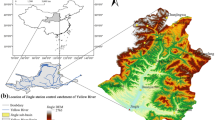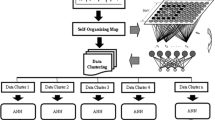Abstract
Accurate hourly real-time flood forecasting is necessary for early flood warning systems, especially during typhoon periods. Artificial intelligence methods have been increasingly used for real-time flood forecasting. This study developed a real-time flood forecasting model by using back-propagation networks (BPNs) with a self-organizing map (SOM) to create ensemble forecasts. Random weights and biases were set for the BPNs to learn the characteristics of a catchment system. An unsupervised SOM network with a classification function was then used to cluster representative BPN weights and biases; clusters of BPNs with high accuracy were selected to act as experts for the ensemble models to forecast flow rates. The model was applied to flood events in the Wu River Basin of Taiwan. Most observed values were within the forecasting intervals of the BPN clusters in the calibration and validation phases, indicating that the models had acceptable accuracy. For the large flood events of typhoons Saola in the calibration phase and Soulik in the validation phase, the mean average error of the ensemble mean model for the cluster A was 143.1 and 327.4 m3/s, respectively; these values were lower than those for the best individual model within the cluster (194.3 and 917.9 m3/s). The ensemble model thus outperformed the individual models and can accurately forecast flood values and intervals. Therefore, the model can be used to accurately forecast floods.














Similar content being viewed by others
Availability of Data and Materials
The raw and processed data required to reproduce these findings cannot be shared at this time because the data are being used in another ongoing study.
References
Adikari KE, Shrestha S, Ratnayake DT, Budhathoki A, Mohanasundaram S, Dailey MN (2021) Evaluation of artificial intelligence models for flood and drought forecasting in arid and tropical regions. Environ Model Softw 144:105136
Belmar O, Barquín J, Álvarez-Martínez JM, Peñas FJ, Del Jesus M (2018) The role of forest maturity in extreme hydrological events. Ecohydrology 11(4):e1947
Berkhahn S, Fuchs L, Neuweiler I (2019) An ensemble neural network model for real-time prediction of urban floods. J Hydrol 575:743–754
Buyukyildiz M, Kumcu SY (2017) An estimation of the suspended sediment load using adaptive network based fuzzy inference system, support vector machine and artificial neural network models. Water Resour Manag 31(4):1343–1359
Chen CS, Chen BPT, Chou FNF, Yang CC (2010) Development and application of a decision group Back-Propagation Neural Network for flood forecasting. J Hydrol 385(1–4):173–182
Chen CS, Jhong YD, Fang WC, Yeh CH (2011) Establishing intelligent flood forecasting mechanism by genetic programming. J Chin Inst Civ Hydraul Eng 23(3):237–244
Chiang YM, Hao RN, Zhang JQ, Lin YT, Tsai WP (2018) Identifying the sensitivity of ensemble streamflow prediction by artificial intelligence. Water 10(10):1341
Gao L, Tao B, Miao Y, Zhang L, Song X, Ren W, Xu X (2019) A global data set for economic losses of extreme hydrological events during 1960–2014. Water Resour Res 55(6):5165–5175
Hagan MT, Demuth HB, Beale MH (1996) Neural Network Design; PWS Publishing: Boston. MA, USA
Hao Z, Hao F, Singh VP (2016) A general framework for multivariate multi-index drought prediction based on Multivariate Ensemble Streamflow Prediction (MESP). J Hydrol 539:1–10
Haykin S (1994) Neural Networks: A Comprehensive Foundation. MacMillan, New York, NY, USA
Islam AS (2010) Improving flood forecasting in Bangladesh using an artificial neural network. J Hydroinf 12(3):351–364
Khan Y, Chai SS (2017) Ensemble of ANN and ANFIS for water quality prediction and analysis-a data driven approach. J Telecommun Electron Comput Eng 9(2–9):117–122
Kim SE, Seo IW (2015) Artificial neural network ensemble modeling with exploratory factor analysis for streamflow forecasting. J Hydroinf 17(4):614–639
Kohonen T (1982) Self-organized formation of topologically correct feature maps. Biol Cybern 43(1):59–69
Kumar S (2005) Neural Networks: a Classroom Approach. McGraw-Hill Education (Asia), Singapore
Kumar S, Roshni T, Himayoun D (2019) A comparison of emotional neural network (ENN) and artificial neural network (ANN) approach for rainfall-runoff modelling. Civ Eng J 5(10):2120–2130
Li W, Tsai YP, Chiu CL (2004) The experimental study of the expert system for diagnosing unbalances by ANN and acoustic signals. J Sound Vib 272(1–2):69–83
Liu M, Huang Y, Li Z, Tong B, Liu Z, Sun M, Zhang H (2020) The applicability of LSTM-KNN model for real-time flood forecasting in different climate zones in China. Water 12(2):440
Nagahamulla H, Ratnayake U, Ratnaweera A (2014) Artificial neural network ensembles in time series forecasting: an application of rainfall forecasting in Sri Lanka. Int J Adv ICT Emerg Reg 6(2)
Ouali D, Chebana F, Ouarda TB (2017) Fully nonlinear statistical and machine-learning approaches for hydrological frequency estimation at ungauged sites. J Adv Model Earth Syst 9(2):1292–1306
Rumelhart DE, Hinton GE, Williams RJ (1986) Learning representations by back-propagating errors. Nature 323(6088):533–536
Saba T, Rehman A, AlGhamdi JS (2017) Weather forecasting based on hybrid neural model. Appl Water Sci 7(7):3869–3874
Santos GDC (2021) 2020 tropical cyclones in the Philippines: A review. Trop Cyclone Res Rev 10(3):191–199
Sharghi E, Nourani V, Najafi H, Soleimani S (2019) Wavelet-exponential smoothing: a new hybrid method for suspended sediment load modeling. Environ Process 6(1):191–218
Yang CC, Chen CS (2009) Application of integrated back-propagation network and self-organizing map for flood forecasting. Hydrol Processes Int J 23(9):1313–1323
Zakaria MNA, Malek MA, Zolkepli M, Ahmed AN (2021) Application of artificial intelligence algorithms for hourly river level forecast: A case study of Muda River, Malaysia. Alex Eng J 60(4):4015–4028
Zaki MK, Noda K, Ito K, Komariah K, Sumani S, Senge M (2020) Adaptation to extreme hydrological events by javanese society through local knowledge. Sustainability 12(24):10373
Acknowledgements
We would like to thank the editor and anonymous reviewers for their comments and suggestions to improve the manuscript.
Author information
Authors and Affiliations
Contributions
Conceptualization: You-Da Jhong, Hsin-Ping Lin, and Chang-Shian Chen; methodology: You-Da Jhong, Hsin-Ping Lin, and Chang-Shian Chen; validation: You-Da Jhong, Hsin-Ping Lin, and Chang-Shian Chen; original draft: Bing-Chen Jhong; review and editing: Bing-Chen Jhong; supervision: Bing-Chen Jhong.
Corresponding author
Ethics declarations
Ethical Approval
The authors have complied with the academic norms of Water Resources Management.
Consent to Participate
All authors agreed to participate in this research.
Consent to Publish
All authors have reviewed the manuscript and have consented to its submission for publication.
Competing Interests
The authors declare no conflicts of interest.
Additional information
Publisher's Note
Springer Nature remains neutral with regard to jurisdictional claims in published maps and institutional affiliations.
Rights and permissions
About this article
Cite this article
Jhong, YD., Lin, HP., Chen, CS. et al. Real-time Neural-network-based Ensemble Typhoon Flood Forecasting Model with Self-organizing Map Cluster Analysis: A Case Study on the Wu River Basin in Taiwan. Water Resour Manage 36, 3221–3245 (2022). https://doi.org/10.1007/s11269-022-03197-y
Received:
Accepted:
Published:
Issue Date:
DOI: https://doi.org/10.1007/s11269-022-03197-y




